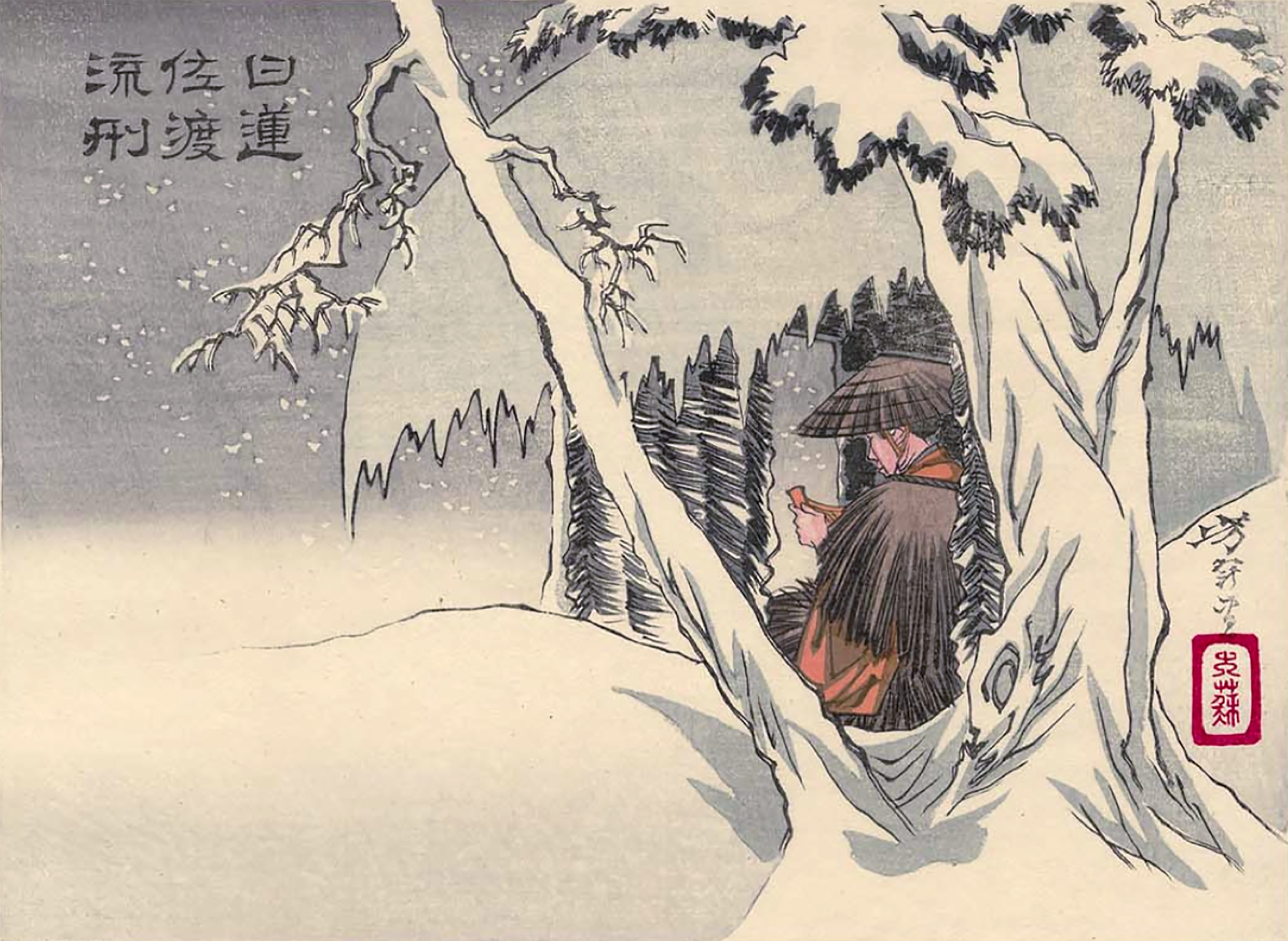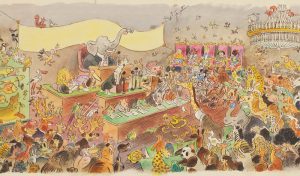The following excerpts are from the introduction to Ikeda Sensei’s series SGI President Ikeda’s Lecture Series: The Opening of the Eyes, pp. 3–9.
The central theme of Nichiren Daishonin’s lengthy two-part treatise, “The Opening of the Eyes,” can indeed be summed up in the short phrase opening the eyes.
While the Daishonin’s original text of this writing is not extant, there is a record indicating that it consisted of a total of sixty-six pages: sixty-five sheets of paper for the body of the work and one sheet of paper on which the Daishonin himself had written “The Opening of the Eyes” as the title page.
“Opening the eyes” means exactly that: “to open the eyes.” It can also be read as the Daishonin’s call: “Open your eyes!”
How can we open the closed eyes of people’s hearts? With what light can we illuminate the darkness of ignorance? It is Nichiren Daishonin, the Buddha of the Latter Day of the Law, who opened a path to answer these questions.
The flame of Nichiren’s struggle as the votary of the Lotus Sutra—a struggle aimed at leading humanity to enlightenment and actualizing the principle of “establishing the correct teaching for the peace of the land” while battling against all manner of devilish functions—only burned even more brightly when he was exiled to snowbound Sado Island. We can discern his unyielding resolve from the following well-known passage of “The Opening of the Eyes”: “This I will state. Let the gods forsake me. Let all persecutions assail me. Still I will give my life for the sake of the Law. … Here I will make a great vow. … I will be the pillar of Japan. I will be the eyes of Japan. I will be the great ship of Japan. This is my vow, and I will never forsake it!” (The Writings of Nichiren Daishonin, vol. 1, pp. 280–81).
From the standpoint of society, he was an exile. Though he was the victim of persecution by the powerful and was innocent of the charges brought against him, he found himself sentenced to exile, a penalty second in severity only to execution and placed in a veritable prison of nature. As was to be expected, however, no chains of any form could ever shackle his spirit.
Throughout the pages of human history, there are many wise people and sages who bravely endured attack and oppression. The Daishonin stands out among them for having declared his intent to save all humankind and secured the path to do so while exiled under the harshest of conditions. “I will be the pillar of Japan,” he cried invincibly. No persecution or devilish force could hinder the Daishonin, who had stood up to fulfill his vow to lead all people to enlightenment.
A person awakened to the inherent Law of life can truly become a colossus of the noblest human spirit.
Nichiren Buddhism is a “religion for all human beings.” It was Nichiren who firmly established the great path of the “human religion” elucidated in the Lotus Sutra, the essence of Mahayana Buddhism, and who left behind the means for all people to realize genuine happiness and lasting peace.
The Daishonin is truly the “pillar,” the “eyes” and the “great ship” of all humankind. However, the befuddled rulers of Japan of his day, as well as perverse and fawning priests dwelling in the world of animals, tried to topple this pillar.
Writing in the Midst of Extreme Conditions
In another writing, “The Actions of the Votary of the Lotus Sutra,” Nichiren Daishonin gives a detailed account of how he came to compose “The Opening of the Eyes”: “After everyone had gone [following the Tsukahara Debate, held in January 1272, on Sado], I began to put into shape a work in two volumes called The Opening of the Eyes, which I had been working on since the eleventh month of the previous year. I wanted to record the wonder of Nichiren, in case I should be beheaded. The essential message in this work is that the destiny of Japan depends solely upon Nichiren. A house without pillars collapses, and a person without a soul is dead. Nichiren is the soul of the people of this country. Hei no Saemon has already toppled the pillar of Japan, and the country grows turbulent as unfounded rumors and speculation rise up like phantoms to cause dissention in the ruling clan. Further, Japan is about to be attacked by a foreign country, as I described in my On Establishing the Correct Teaching. Having written to this effect [in The Opening of the Eyes], I entrusted the manuscript to Nakatsukasa Saburo Saemon-no-jo’s [Shijo Kingo’s] messenger” (WND-1, 772).
In this passage, the Daishonin recalls his sentiments in writing “The Opening of the Eyes,” which he completed in February 1272. He begins by saying that he started planning the treatise in November 1271, immediately after arriving on Sado on October 28.
Nichiren reached Tsukahara on Sado on November 1, amid extremely frigid temperatures. The place where he initially stayed was a dilapidated shrine called the Sammai-do, in the middle of a graveyard. He writes that “it stood on some land where corpses were abandoned” (“The Actions of the Votary of the Lotus Sutra,” WND-1, 769). It was a tiny structure consisting of a single room with four posts. No statues of the Buddha were enshrined there; the boards of the roof did not meet, and the walls were full of holes. It was little more than a deserted shack. In an extreme environment where icy winds blew mercilessly and snow piled high, he placed fur skins on the floor to lie or sit on and spent his days and nights wrapped in a straw coat. In addition to the freezing northern winter to which he was unaccustomed, he also faced a shortage of food provisions. As a result, during November, he sent back some of the young disciples who had accompanied him.
“It is impossible to describe these matters in writing” (“Aspiration for the Buddha Land,” WND-1, 214), the Daishonin says, referring to the deplorable conditions that confronted him on Sado. He admits to feeling as though he had passed through the realm of hungry spirits and fallen alive into one of the eight cold hells (see “Letter to Horen,” WND-1, 519). He also observes: “Exiles to this island seldom manage to survive. Even if they do, they never return home. So no one is going to be punished for killing an exile” (“The Actions of the Votary of the Lotus Sutra,” WND-1, 771).
In such a perilous environment, Nichiren immersed himself deep in thought and composed an important work for the enlightenment of humankind. Over the course of approximately three months, he planned out and wrote this treatise, which, in terms of current Japanese standard, four-hundred-character manuscript pages, comes to more than one hundred pages in length. After arriving on Sado, he set to work right away on this task to lead all people to Buddhahood.
Discussing the Daishonin’s spiritual state while on Sado, President Toda once remarked: “Buddhahood is a state of absolute happiness. A state of being that at each moment is like a translucent ocean or a cloudless sky, utterly invincible and fearless—this is how I perceive the Daishonin’s state of life during his exile on Sado.
“When the Daishonin says, ‘Sacrificing your life for the Lotus Sutra is like exchanging rocks for gold or dung for rice’ (“The Actions of the Votary of the Lotus Sutra,” WND-1, 764), and ‘For what I have done, I have been condemned to exile, but it is a small suffering to undergo in this present life and not one worth lamenting. In future lives I will enjoy immense happiness, a thought that gives me great joy’ (“The Opening of the Eyes,” WND-1, 287), I keenly feel that this portrays the state of life of the Buddha of the Latter Day.”
In fact, while living under conditions of indescribable hardship, Nichiren earnestly pondered the question of how he could enable all people to attain Buddhahood; and he clearly constructed the means for achieving this goal by writing “The Opening of the Eyes” and “The Object of Devotion for Observing the Mind.” As I have said, what sets the Daishonin apart in greatness from countless other historic figures who have endured persecution is that he, amid extreme difficulties, laid a solid foundation to thoroughly secure the path for the enlightenment of all humanity.
“The Opening of the Eyes” Was Written After Nichiren Revealed His True Identity
In the passage from “The Actions of the Votary of the Lotus Sutra” that I cited earlier, Nichiren says that his purpose in writing “The Opening of the Eyes” was to leave a record for posterity of the “wonder of Nichiren.” We can surmise that the greatest “wonder of Nichiren” that he seeks to record here is his casting off his transient status and revealing his true identity at the time of the Tatsunokuchi Persecution.
On the occasion of his near-execution at Tatsunokuchi, the Daishonin discarded his transient aspect as “an ordinary person at the stage of hearing the name and words of the truth” (that is, someone who has taken faith in the Lotus Sutra) and revealed his true state of life as “the Buddha of limitless joy enlightened from time without beginning,” a state of complete freedom that is at one with the eternal Mystic Law.
As a result of the Daishonin casting off the transient and revealing the true, the path to attaining enlightenment in one’s present form—whereby we can manifest Buddhahood in our ordinary mortal lives, just as we are—was opened to all people.
As he describes in detail in “The Opening of the Eyes,” he won this fundamental victory of life—the victory of casting off the transient and revealing the true—in the course of his relentless struggle to surmount persecution after persecution and triumph over all obstacles. In the same way, when we maintain courageous faith, unafraid of any obstacles, then, no matter what happens, we, too, can defeat the darkness of ignorance and establish a self that manifests our enlightened Dharma nature. This is how we cast off our own transient aspect and reveal our true selves. Casting off the transient and revealing the true is essential to our attainment of Buddhahood in this lifetime.
As Nichiren indicates when he says, “Here a single individual has been used as an example, but the same thing applies equally to all living beings” (“The Unanimous Declaration by the Buddhas,” WND-2, 844), his casting off the transient and revealing the true elucidates the basic principle for attaining Buddhahood that applies to all people of the Latter Day of the Law; it is also proof of this principle and an example for others.
All people, if they possess unwavering faith in the Mystic Law, can develop a state of being as vast as the universe in their flesh-and-blood lives as ordinary people. You could say that Nichiren Daishonin was the very first person to demonstrate the truth that all people of the Latter Day could cast off the transient and reveal the true. To verify his casting off the transient and revealing the true and to provide a “clear mirror” or means so that others could do the same, Nichiren manifested the Gohonzon in a concrete graphic form.
The Daishonin is truly the pillar of all humankind, because his example of discarding the transient and revealing the true makes it possible for all people to bring forth their own inherent Buddha nature. Herein lies the most profound significance of his assertions that “the destiny of Japan depends solely upon Nichiren,” and “Nichiren is the soul of the people of this country” (“The Actions of the Votary of the Lotus Sutra,” WND-1, 772).
Opening the eyes is thus also a call “to open your eyes to Nichiren.
Opening Our Eyes to the Spirit of “Not Begrudging One’s Life”
Opening our eyes to Nichiren means opening our eyes to the votary of the Lotus Sutra and, therefore, also opening our eyes to the Lotus Sutra. In this way, multiple meanings apply to the phrase opening the eyes, as is evident in various passages in “The Opening of the Eyes.” I would now like to cite a number of specific passages where the Daishonin in effect urges us: “Open your eyes to Nichiren.”
First of all, there is the well-known passage I quoted earlier that alerts us to open our eyes to the Daishonin’s casting off the transient and revealing the true: “On the twelfth day of the ninth month of last year [1271], between the hours of the rat and the ox (11:00 p.m. to 3:00 a.m.), this person named Nichiren was beheaded. It is his soul that has come to this island of Sado and, in the second month of the following year, snowbound, is writing this to send to his close disciples. [The description of the evil age in the “Encouraging Devotion” chapter seems] terrible, but [one who cares nothing about oneself for the sake of the Law has] nothing to be frightened about” (WND-1, 269).
Indeed, in this passage he is saying, “Open your eyes to the ‘soul’ of Nichiren.” He essentially declares: “The ordinary person Nichiren was beheaded at Tatsunokuchi. It is the ‘soul’ of Nichiren that is now writing ‘The Opening of the Eyes’ on Sado.” “Soul,” here, refers of course to the “Buddha of limitless joy enlightened since time without beginning” that is the true identity revealed by Nichiren when he cast off his transient status.
Here, I would like to focus on the fact that, in terms of the overall structure of “The Opening of the Eyes,” this passage comes right at the start of the section where the Daishonin explains how he read the Lotus Sutra with his life, especially “Encouraging Devotion,” the 13th chapter. In this passage, he declares that no matter how fearful the descriptions in the “Encouraging Devotion” chapter of the ways that the three powerful enemies will persecute the practitioners of the correct teaching, these things are not in the least frightening to the soul of Nichiren. In this way, he shows us a glimpse of the vast and fearless state of the Buddha of limitless joy enlightened since time without beginning.
The “Encouraging Devotion” chapter details the terrible persecutions that will befall the votaries of the Lotus Sutra in the evil age after the Buddha’s passing, describing, for example, how the three powerful enemies will incite the secular authorities to repress the votaries. There is also a scene where a multitude of bodhisattvas numbering “eight hundred thousand million nayutas” make a vow to struggle with the spirit of not begrudging their lives when encountering such life-threatening persecutions. The “Encouraging Devotion” chapter contains the lines, “We care nothing for our bodies or lives / but are anxious only for the unsurpassed way” (The Lotus Sutra and Its Opening and Closing Sutras, p. 233). It expounds that the intrepid spirit of not begrudging one’s life and seeking solely to enable all people to enter the unsurpassed way to Buddhahood is a fundamental requisite of bodhisattvas.
In “Letter from Sado,” which was written around the same time as “The Opening of the Eyes,” Nichiren asserts that when evil priests seeking fame or profit conspire with ignorant officials to unjustly attack the votary of the Lotus Sutra, those with the selfless “heart of a lion king” can attain Buddhahood (see WND-1, 302).
Accordingly, we can read the phrase opening the eyes as including the meaning: “Open your eyes to Nichiren’s spirit of not begrudging his life.”
You are reading {{ meterCount }} of {{ meterMax }} free premium articles





